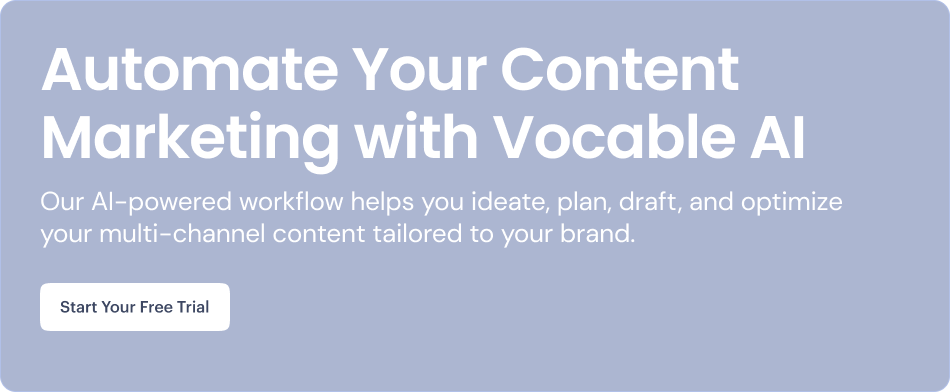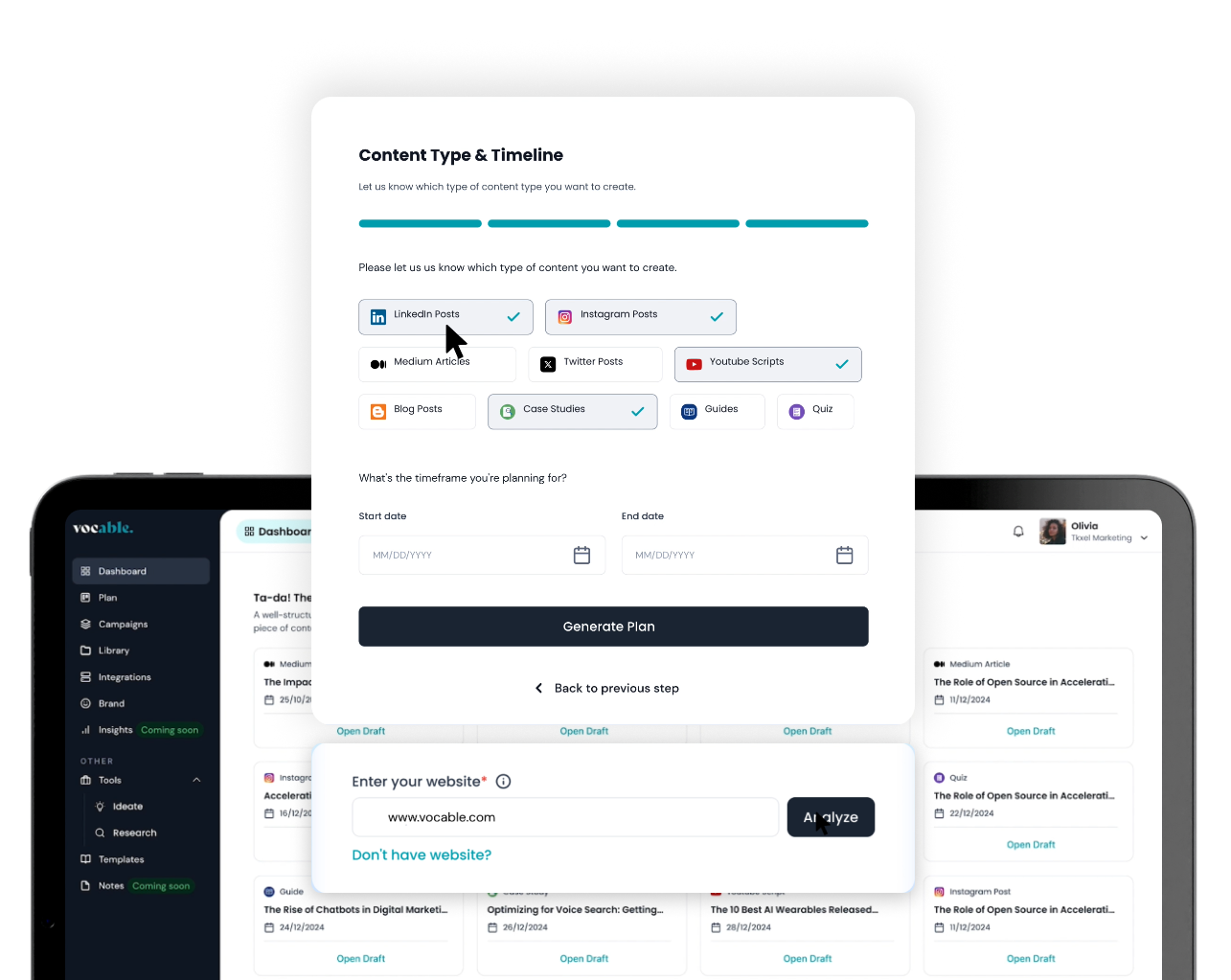5 Transformative AI Content Creation Strategies You Cannot Miss

Vocable TeamDecember 31, 2024 4 min read
AI has changed (and is continuously changing) how we create content. Not quite convinced? Here are some statistics from SurveyMonkey about the usage of AI tools in digital marketing today.
- 73% of marketers say AI helps create personalized customer experiences.
- 50% use AI tools to generate content, including blog posts and articles.
- 45% rely on AI to brainstorm fresh content ideas.
- 41% analyze data with AI to uncover valuable insights.
- 43% of marketers automate tasks and processes using AI software.
- 51% optimize content for email campaigns and SEO with AI tools.
- 43% believe AI is an important part of their social media strategy.
The above list can be expanded to faster content turnarounds, reduced human effort for creative content, improved personalization, and more… each creator finds solutions to their own professional hurdles.
“AI can’t help creating a type of content that humans can,” – someone may shout from the parallel universe.
“It can if used right,” – we would confidently shout back.
In this blog article, we help readers squeeze the maximum out of AI for content creation.
Yes, it won’t be a good idea to delegate an entire project to a content creation AI, considering the fact-checking and smooth-flow issues that most AI algorithms still face.
But here’s the deal! You let AI do what it does best-performing certain separate content creation tasks and then bringing the puzzle together, adding that human touch to perfect it.
What Is Generative AI?
This world-shaking technique is a subset of artificial intelligence that uses deep-learning models to produce creative and original content based on the large data it is trained on.
AI-powered content creation systems take a huge amount of raw data from the web and learn to generate something similar (but not the same) outputs whenever users give corresponding prompts.
Explaining it on the example of text-based models, an AI-driven content creation system “reads” and “learns” from a large number of text passages available on the net – from Wikipedias, research papers, and e-books.
When you prompt it to generate a content piece on a topic, it uses the knowledge it gained from reading those texts and spits out a unique piece that is not copied but written in its own style.
Here, we have two things you should know:
- AI-automated content creation tools don’t know if their output is accurate or if the data they’re based on is true. So, you should always run a fact-check when you use AI-powered content creation tools.
- Even the best AI for content creation relies on the information available on the net to produce outputs. This information includes copyrighted materials, inaccurate data, and personal opinions, so AI may sometimes produce misleading or biased results. Again, using AI for content creation shouldn’t free you from the responsibility of verifying its outputs.
Generative AI in Content Marketing
Content creation with AI currently serves one big goal – it generates human-like content of different types, including text, graphics, audio, and more!
So, content creators like you, previously burdened with repetitive mechanical tasks and struggling with the constant need to be in the creative flow, now have a wonderful opportunity to concentrate on the bigger picture and more complex tasks.
With AI taking care of mundane content creation tasks, marketers can focus on strategy, analysis, and other critical aspects of their work.
If you want to know how to use AI for content creation, the answer is in any possible way, as long as you can give accurate prompts and verify that the AI output is helpful.
Different content creators “invent” different use cases of AI in content creation, and there are pretty broad horizons to experiment with. From ideation, outlining, drafting, designing, and even posting, AI is all set to take a significant portion of the burden off content marketing managers’ backs.
So, how exactly can you use AI content creation in your business? Let’s discuss some transformative techniques that you should not miss out on!
AI Content Creation Strategies to Implement Right Now
Though your own experiments with AI-based content creation are always welcomed and appreciated, some AI applications have already proven effective based on market research and case studies.
Below, we’ve listed the top five transformative AI content creation techniques you should implement in your marketing strategy.
Besides theory, we also include some ready-to-use features of Vocable – a content automation platform that can help you start building AI-generated content right off the bat.
1. Content Research and Ideation
What every content creator dreads the most is writer’s block. How amazing would it be if someone just waved a magic wand, and your content ideas were ready in minutes? This is where AI content creation can come to your rescue.
AI helps generate different ideas within your suggested topic – be it a blog post outline, CTA banner for a specific audience, podcast episode ideas for an uninterrupted weekly podcast series, or anything else.
In parallel to analyzing readily available content on the web, content creation AI starts learning insights and behavioral trends of your target audience, suggesting ideas that resonate with your readers’ preferences and style.
While it may take you hours to develop 1-5 captivating ideas for your next content piece, AI can do the same task in seconds and present you with dozens of leads to choose from.
Ideate with Vocable in 3, 2, 1 Clicks
Vocable’s Ideate and Research features are powered by AI models that can brainstorm ideas for any content task you assign it to.
You prompt the specifics of your next content piece by filling in the blanks such as topic, the type of generated content, tone, style, and target audience.
In response, Vocable offers you several outlines, headlines, sentences, and even statistics that can be later used in your text or graphics.
For example, see the blog headlines Vocable suggested we use in the blog post related to AI content creation.
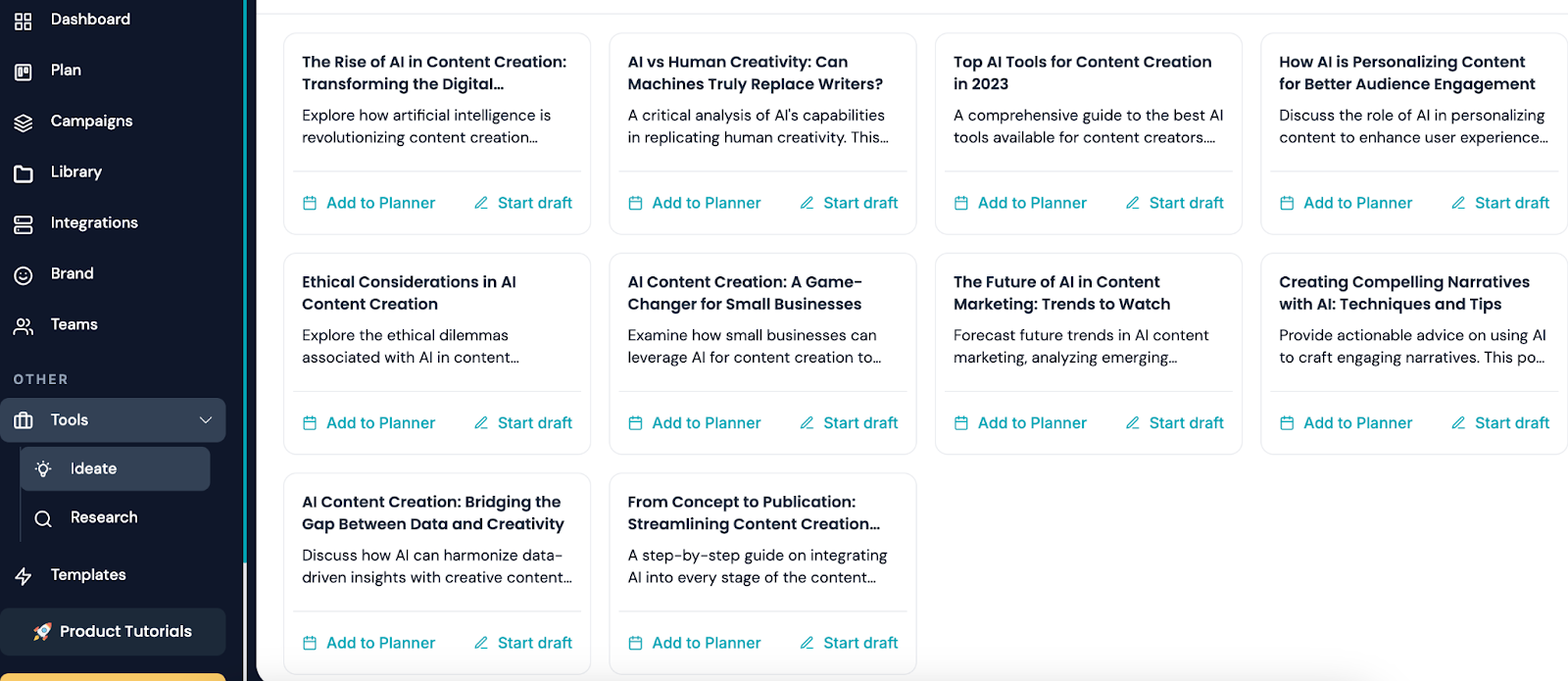
And here’s which podcast episode ideas the platform hints us to use based on the same topic.
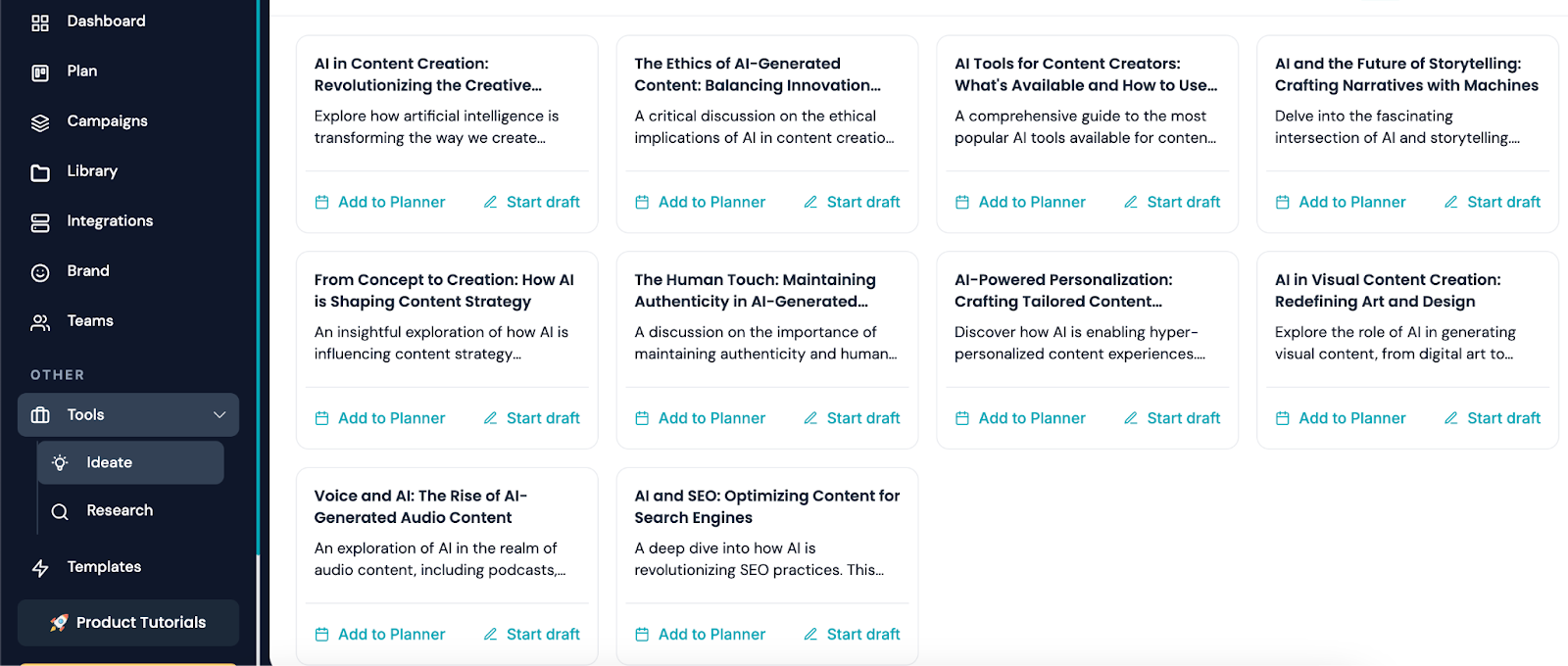
Seems we should start a show on AI content marketing right away!
Research with Vocable for the Best SEO Keywords
Vocable can also help you find critical SEO keywords for your next content piece, along with search volume, keyword difficulty, top results for the keyword, queries, etc.
Once you insert the topic, Vocable AI will look through the web to bring you all the SEO insights and other hints that can help make your content rank better.
2. Sentiment Analysis and Emotional Intelligence
One of the advancements of AI for e-commerce content creation is its ability to conduct sentiment analysis. This is a process of analyzing a vast amount of textual data (usually customer reviews and feedback), which helps to find the overall emotion expressed in this data.
In other words, sentiment analysis helps:
- Determine whether most customers like or dislike your brand
- Which key points of your product or services they’re most excited about
- What aspects of your product or service can be improved
Analyzing all shared feedback of customers manually is tedious and takes a long time. You’d have to read every comment closely, highlight positive and negative phrases, and then analyze the data to find patterns. With AI sentiment analysis, you can do this in minutes.
By analyzing customer feedback, AI models become smarter and learn to produce more customer-oriented product descriptions that catch attention.
There are different approaches to AI sentiment analysis.
- Rule-based approach: A set of rules is created that determine if the text is positive, negative, or neutral. The AI then analyzes the data based on those rules.
- Machine learning approach: The AI uses large datasets of labeled data to teach AI to identify patterns in texts and categorize them into negative and positive—a more complex but more accurate approach than rule-based.
- Lexicon-based approach: A pre-built lexicon or glossary of words/phrases grouped into positive or negative sentiments is provided. Based on which words are more frequently used in the text, AI product content creation tools score the text as positive or negative.
3. AI-Powered Article Outlines
Content writers with different experience levels state it usually takes three to five hours to generate a killing blog post outline – the one that would actually convert users.
It normally takes a lot of time to skim-read the top-ranking articles on the topic, understand their main messages, and then put them together to make up a novel angle for your content.
Of course, a guardian angel AI for content creation comes for help, generating the content outline from a few seconds to minutes.
Again, you should be careful with the output because your AI-powered content creation platform will probably create something quite similar to your competitors.
But as we all know, the outranking content is the one that goes a step further, not just copying the best results on the SERP but adding a personal touch to it in some way.
So, how do you create article outlines with AI-driven content creation?
If you’re using a chat-like AI editor, you can create a detailed and clear prompt. Something similar to the example below may be a good start.
“Generate a blog post outline for the topic “The Importance of Emotional Intelligence in the Workplace”. Use the target keyword “emotional intelligence” and generate an article for a rough length of 1000 words. The blog will target managers and HR professionals of middle- and large-sized companies. We need to organically promote our emotional intelligence training course and offer a free trial in the article.”
Generate Article Outline with Vocable in a Quicker Way
You can also have a more straightforward way of blog post outline generation. Vocable’s template for article outlines is already trained to create an SEO-optimized blog post structure with an introduction, main headings, subheadings, conclusion, and call-to-action.
You only need to input a few additional details about your requested content – see how we did that in the screenshot.
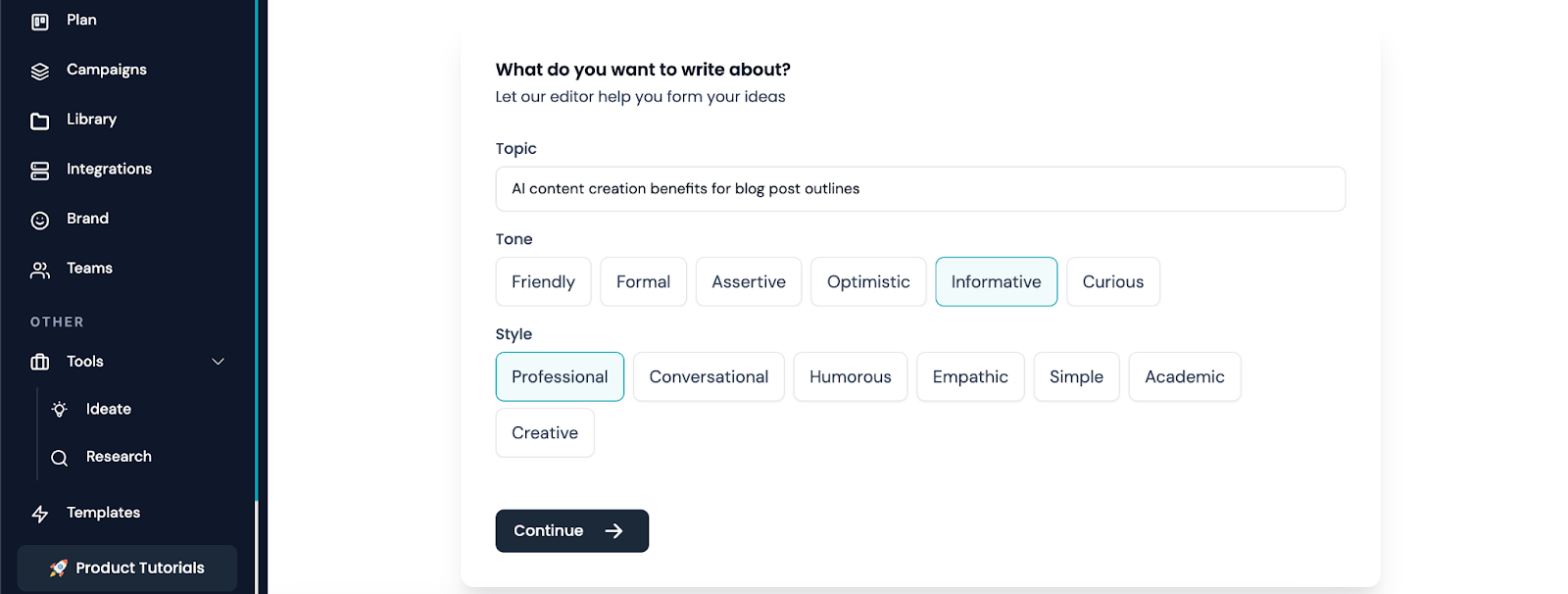
And here’s what Vocable created for us in a snap.
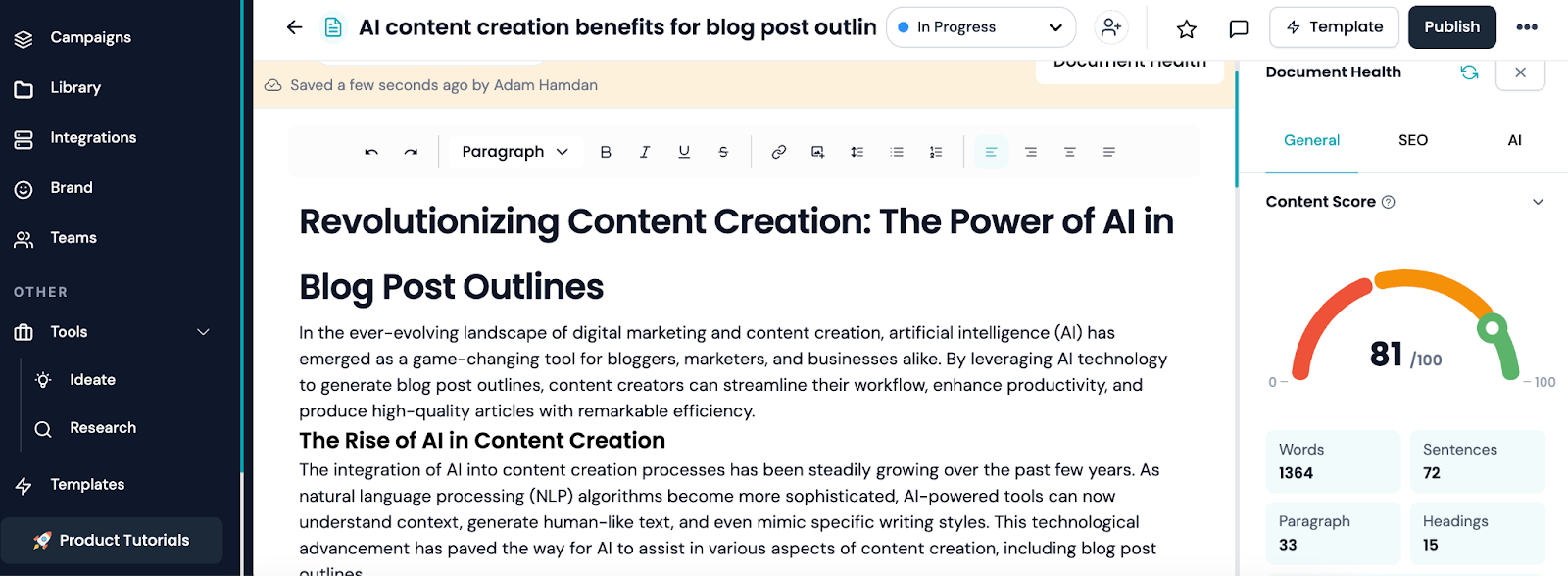
4. AI Content Editing and Proofreading
Grammar matters for SEO rankings. If you publish content with too many errors – be it grammar or spelling, you signal to search engines that your content is not trustworthy and credible. This, in turn, negatively affects your page’s position on the SERP.
So, an irreplaceable part of your AI-based content creation platform should be an AI-powered editing and proofreading tool. It should take care of the grammar, spelling, typos, homophones, and other issues as you write or edit your content.
Other than that, it would be great to have an AI-automated content creation tool that also mimics your brand voice. This helps make your content unique, recognizable, and engaging.
Vocable: An All-Inclusive Document Health Checker
Whenever you upload your written content to Vocable’s editor or ask it to generate an article outline, Vocable checks it for errors and offers corrections based on your brand voice.
Above basic grammar and syntax issues, here you give comprehensive feedback on your text’s readability, accessibility, style, sentence structure, and more!
Clicking on each separate section, you can see which personalized suggestions Vocable gives and apply them to your content.
Vocable scores your content based on the accepted industry standards, like Flesch Reading Ease. So, if your content has a high overall health score, you have a higher chance for it to rank higher on the SERP (not forgetting other crucial ranking factors like meeting search intent, proper content length, and others).
5. Predictive Analytics for Content Performance
AI content creation is not only for generative purposes but also for predictive analytics. The latter means Artificial Intelligence uses the previous performance history of the content to predict outcomes of a similar new content piece.
In terms of predicting the success of your future content, AI-driven tools use machine learning to analyze millions of search queries and user behavior data in order to identify patterns that make certain types of content more successful than others.
Here’s where predictive AI can help you!
Personalized AI Product Content Creation for Online Retail
One of the most popular predictive analytics applications is AI product content creation for online shops.
For example, when Amazon creates personalized product suggestions for you, it uses predictive analytics based on:
- Your purchase history
- Items you browsed
- Items you clicked
- How long you spent on a particular product page
- Products added to your wishlist or cart
It then uses this data to recommend products that are most likely to interest you.
Optimizing Content Strategy
Content creation AI also analyzes content performance metrics to predict the success of future content pieces. These metrics include:
- Click-through rates
- Time spent on a page
- Bounce rates
- Social shares
This helps content creators optimize their content strategy by identifying what type of content performs better and what topics are more popular with their target audience.
For example, if you are a content marketer writing about technology, AI can tell you that your audience responds better to articles on the latest gadgets than to analysis pieces. This helps you focus your efforts and resources on creating content that will bring in more engagement and conversions.
Best Practices of AI-Based Content Creation
“By combining human intuition and creativity with AI’s computational power and data analysis, we can unlock remarkable opportunities for innovation across industries“.
AI is a powerful tool, but it still needs human input and direction to create high-quality content. We, as human beings, have an absolute privilege over AI in terms of our unique ability to understand emotions, draw on moral values, and convey them through powerful storytelling.
While AI can spot patterns in data and generate content based on algorithms, it cannot evoke emotions or appeal to human empathy.
So, one of the first tips to make the most of AI in content creation is not to completely rely on it. Instead, use it as a tool to enhance your creativity and productivity.
Here are some other tips for using AI-based content creation effectively.
Comply with Legal and Ethical Considerations
You are free to use any AI content creation platform for your content generation since they’re publicly launched and available for general use. However, using AI for content creation does not free you from the responsibility of ensuring that the content created is legal, ethical, and accurate.
You bear the consequences of any legal ramifications arising from content written by an AI tool on your behalf. This can include copyright infringement, plagiarism, or violating any other laws.
Carefully review and fact-check all content generated by AI tools before publishing it. Make sure that the tool you are using is transparent about its content sources and adheres to ethical standards in content creation.
Be Selective with the Tools You Use
There are plenty of AI content creation tools available in the market, from popular names like ChatGPT to just emerging ones that are making their first steps in the content creation industry.
When assessing the reliability and quality of the AI-powered content creation tools, it’s important to look at the LLM (Large Language Models) these tools are trained on.
In simpler words, if the model isn’t trained on the LLM of a sufficient size, it takes its content suggestions from a narrow pool of content data. This means that the generated content will have limited variation and may not be as high-quality as expected.
Check Vocable’s blog for the cherry-picked list of the top AI content creation tools for different industries and purposes.
Train and Customize Your AI Platforms to Fit Your Brand Identity
Uploading updated content guidelines, tone of voice, and brand persona to the AI tool before beginning content generation can help ensure that the generated content aligns with your brand’s identity.
It’s one of the most important goals of any aspiring content strategist to ensure all the content they release reflects the brand’s image, style, and tone. You should sound the same everywhere to boost brand awareness, maintain consistent customer experience, and foster brand loyalty.
Explore the Promising Horizons of AI Content Creation with Vocable
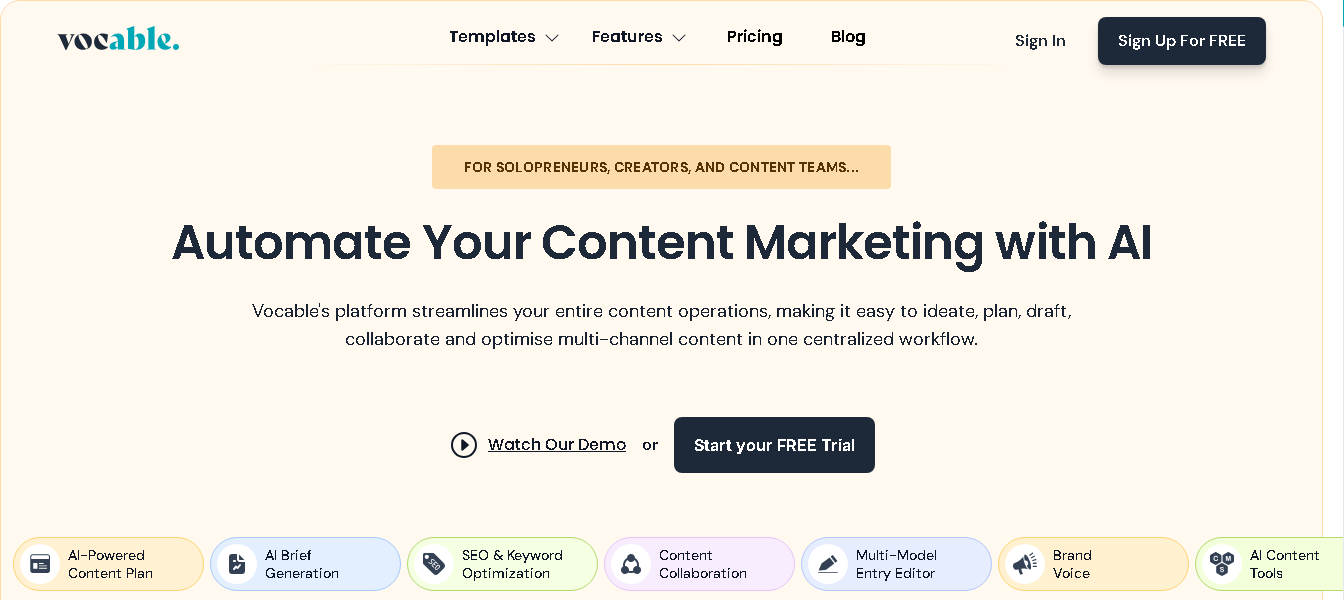
Give a try to an all-in-one AI content creation solution that simplifies your content creation process from A-Z, starting from research and generation to optimization and publishing.
Vocable is handy for individual writers and creators who want to save time and effort on content creation. And it’s also great for content teams who need smooth collaboration and workflow management to create high-quality, consistent content.
- Fresh ideas instantly: Get tailored suggestions for blogs, social media, emails, and more.
- All-in-one workflow: Plan, draft, and edit seamlessly without switching tools.
- Save hours: Generate content ideas and drafts in just minutes with AI support.
Try Vocable for free today to unwrap advanced functionality tailored to your specific needs and industry.
FAQs About AI Content Creation Strategies
How can AI be used for content creation?
AI can help create engaging content by automating repetitive tasks and simplifying the writing process. Using natural language processing, AI tools analyze large amounts of data to understand trends, audience preferences, and tone. These insights guide the creation of relevant content, such as social media posts, blog articles, and email campaigns.
What is the AI content strategy?
An AI content strategy uses AI-powered tools to plan and create content that meets your goals. It starts with analyzing data to find topics your audience cares about. Then, AI helps write and organize content like blogs or social media posts. Using natural language generation, these tools help refine your tone and style, aligning with your brand’s goals. It can also help schedule and share your content, making your content marketing strategy more effective.
What is the best AI tool for content creation?
The best AI tool for content creation depends on your specific needs. Some tools specialize in generating engaging content for blogs, while others focus on creating social media posts or analyzing data for better planning. One great example is Vocable.
How to use AI for content planning?
AI makes planning easier by finding trends and suggesting topics. AI-powered tools can organize content calendars and recommend what to post and when. With natural language processing, these tools refine your style and tone. This helps you deliver relevant content and improve your digital marketing results.
Get Started with Vocable
Master every aspect of Vocable, from automated content planning to publishing in these step-by-step tutorials and product guides.
Get Started Now


